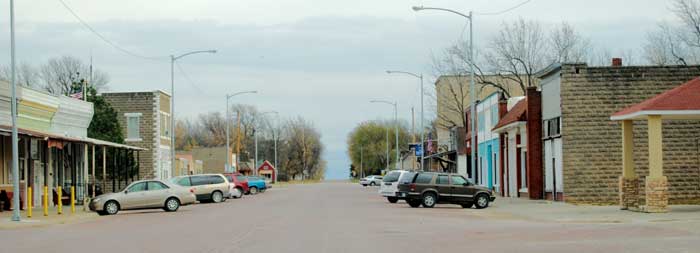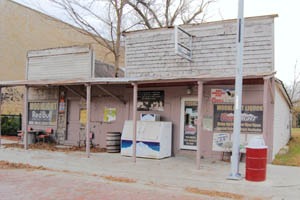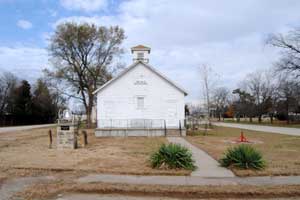White City, Kansas, located in northwest Morris County, was established after a colony was organized in Chicago, Illinois, under Reverend Pierce, to make themselves homes in some Western states.
While making their plans, correspondence was opened up between Mr. Pierce and Mr. Somers of Council Grove, agents for many railroad lands. When the colony was ready to start westward, Mr. Somers proceeded to Chicago to complete its organization and accompany it to Morris County. The group numbered about 40 families. The place first selected was only about three miles from Parkerville. Afterward, it moved about two miles further to the north to land owned by T. S. and W. J. Mackenzie, who actively organized the colony. The Mackenzies had earlier purchased 80 acres of ground on either side of the Missouri-Kansas-Texas Railroad tracks.
White City was founded in 1871 and was named for F.C. White, superintendent of the Neosho division of the Missouri-Kansas-Texas Railroad, built on the land in 1868, before the community’s existence.
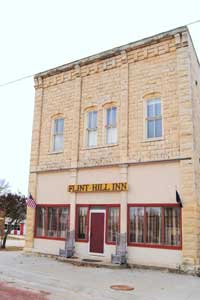
The old Jenkins Brothers Store still stands in White City and is now the Flint Hill Inn by Kathy Alexander.
In 1871 the Mackenzies had the townsite surveyed, and the building soon began. A post office opened on January 2, 1872, Thomas Eldridge built the first house, and James Thornley and W. N. Dunbar erected the first store. Soon, more homes and businesses were built, including the Commercial Hotel, accommodating guests, railway travelers, and settlers to view homesteads. Soon a school was needed, and the citizens voted $1,200 to build a 20×30 foot stone school building in 1873 and hired a teacher.
By the early 1880s, there were three general stores, a drug store, a grocery store, a millinery shop, two wagon shops, and two grain elevators.
One of the general stores, known as the Jenkins Brothers Store, was built in the winter of 1885. The two-story limestone building was constructed from limestone from a quarry located three miles from White City. For the next 54 years, the 6,000 square foot building would continuously operate as a general store, supplying all manner of products. In 1939, the Jenkins Brothers partnership dissolved, and for many years the building stood vacant. Today, it serves as an art gallery, law office, apartment, and bed and breakfast called the Flint Hill Inn. Listed on the National Register of Historic Places, the Jenkins Building is located at 101 W. Mackenzie Street.
The Methodists and the Congregationalists also erected frame churches. By that time, the settlement had become a shipping point for the area farms and had a population of about 200.
In 1887, the town gained a second railroad when the Chicago, Kansas, & Nebraska Railway built a mainline from Topeka through White City to Herington. A few years later, the railway was foreclosed on in 1891 and taken over by Chicago, Rock Island & Pacific Railway.
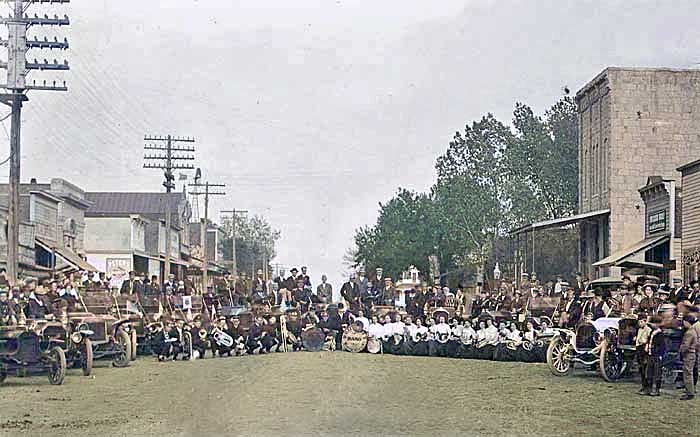
White City, Kansas Celebration early 1900s. Touch of color by LOA.
The town continued to grow over the following decades. By 1910, it boasted two banks; a weekly newspaper called the Register, several retail establishments, telegraph and express offices, and an international money order post office with four rural routes. At that time, the population was a little more than 500 people. Ten years later, White City’s population peaked at 652.
The first significant blow to the town’s economy occurred after the nearby Delevan Air Force Base at Herington was closed down shortly after World War II.
In the 1950s and 1960s, both railroads slowly phased out operations through White City, taking jobs and a major mode of transportation with them. Finally, in June 1969, a tornado hit the town, leaving heavy damage to the hotel, the Brown Motor Company, and the Methodist church.”
Today, White City is still called home to about 450 people. It is known as the “Little City on the Hill,” as it sits on one of the highest elevations in the Flint Hills. The small community peeks at its history at the one-room Baxter School House and the KATY Railroad Rail Car Museum. A bed-and-breakfast inn is located in a historic two-story stone store.
White City is located along Highway 4, about 24 miles northwest of Council Grove.
Compiled and edited by Kathy Alexander/Legends of Kansas, updated May 2022.
Also See:
Extinct Towns of Morris County
Sources:
Blackmar, Frank W.; Kansas: A Cyclopedia of State History, Vol I; Standard Publishing Company, Chicago, IL 1912.
Cutler, William G; History of Kansas; A. T. Andreas, Chicago, IL, 1883.
Hollis, Brooke L.; A Sketch of White City, Kansas: A Colorful Past, The Chapman Center for Rural Studies, 2011.
Kansas Towns
Wikipedia

